Embedding Sustainability into Service Policies and Procedures Report
VerifiedAdded on 2022/11/13
|9
|2385
|173
Report
AI Summary
This report delves into the critical aspects of sustainability management within an early childhood service setting. It begins by outlining the development of a comprehensive sustainability management plan, emphasizing the identification of key issues, setting objectives, creating action plans, and monitoring progress across the dimensions of people, planet, and profit. The report then explores sustainable practices tailored for children, highlighting strategies to foster their understanding and respect for the natural environment through education, hands-on activities, and the promotion of reduce, reuse, and recycle principles. Furthermore, the report addresses the importance of involving others, including families and the community, in implementing sustainable practices. It suggests various methods for encouraging participation, such as leading by example, organizing educational events, and incentivizing engagement. Finally, the report examines the critical process of embedding sustainability into service policies and procedures, emphasizing the need for regular review, stakeholder involvement, and the alignment of organizational philosophy with practical actions. The report concludes by emphasizing the importance of integrating sustainability into all facets of service operations to ensure long-term environmental responsibility and positive impacts on future generations.
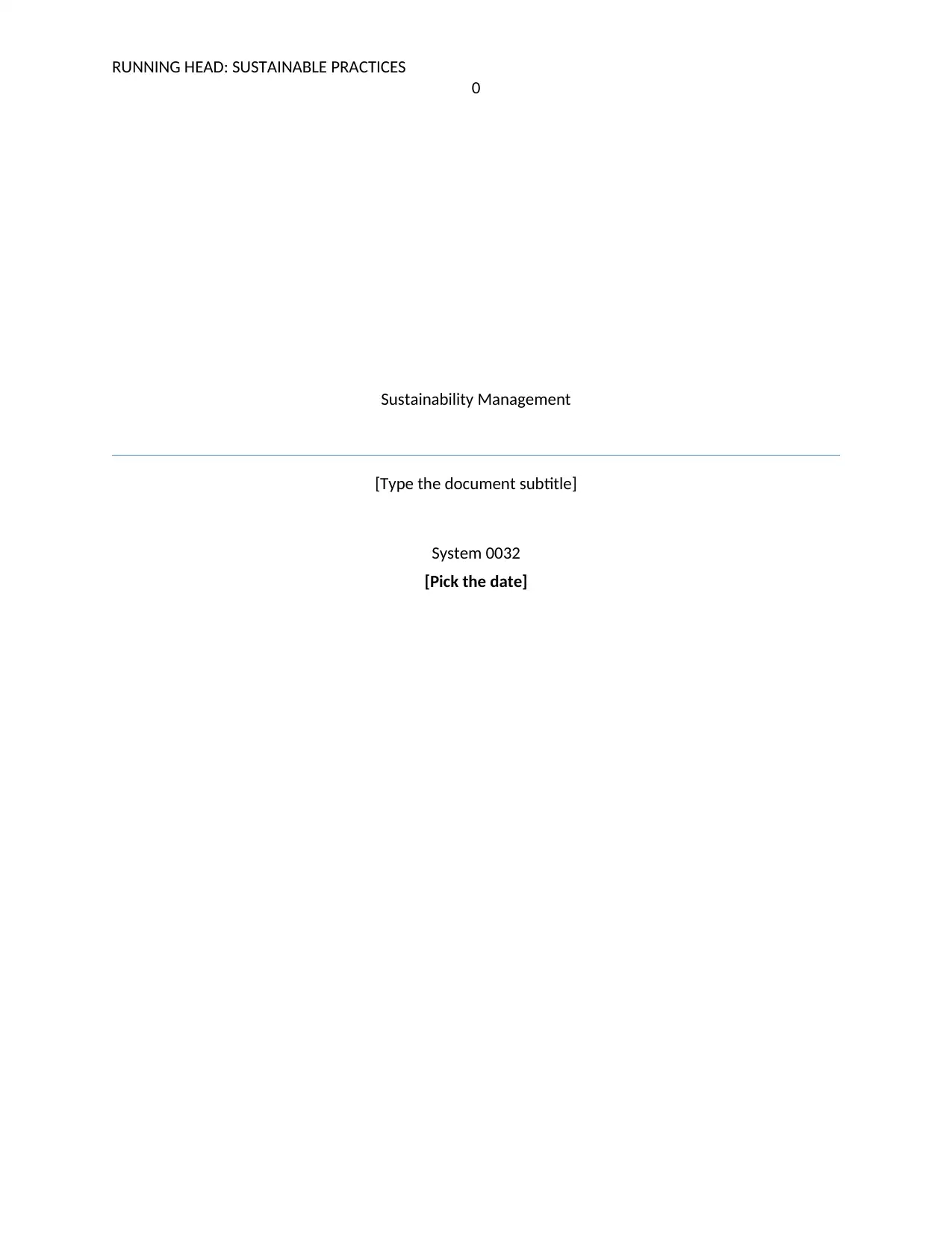
RUNNING HEAD: SUSTAINABLE PRACTICES
0
Sustainability Management
[Type the document subtitle]
System 0032
[Pick the date]
0
Sustainability Management
[Type the document subtitle]
System 0032
[Pick the date]
Paraphrase This Document
Need a fresh take? Get an instant paraphrase of this document with our AI Paraphraser

Question 1
Sustainability Management Plan
Sustainability management becomes an important concept in the current situation. Sustainability
is defined as the meeting the current needs of individuals without compromising with the future
needs or it simply means satisfying wants of all the people with the limited use of natural
resources (Young & Elliott, 2014). A sustainability management plan in service includes
following steps identifying the issues related to sustainability, setting up of objectives,
developing an action plan to achieve those objectives and then implementing all the changes and
at last monitoring or evaluating the progress. The aspects of sustainability include people, planet
and profit. Every activity requires use natural resources, every aspect of life depend on nature as
nature is giver and humans are the takers. The sustainable management plan comprises of
understanding environmental issues and then identifying areas that needed to be changed. Here
educating children about these issues is essential and it is their responsibility to practice
sustainability and manage nature and natural resources (Davis, 2015). The first step in the
sustainability management plan is to know or find the areas that need improvement.
Service aspect
Nature Constructed a garden with parents and children involvement
A cubby house constructed from bamboo
Use of worm farm
Waste Increased reuse and resourcefulness
Papermaking activities with children by using shredded office papers
Implemented concept of reduce reuse recycle
Green Bin used for garden organic
Energy Ensure using of natural lights and ventilation
Using efficient light globes
Audit on all the electronic appliances to reduce the consumption of energy
Toxins Using eco-friendly products
Sustainability Management Plan
Sustainability management becomes an important concept in the current situation. Sustainability
is defined as the meeting the current needs of individuals without compromising with the future
needs or it simply means satisfying wants of all the people with the limited use of natural
resources (Young & Elliott, 2014). A sustainability management plan in service includes
following steps identifying the issues related to sustainability, setting up of objectives,
developing an action plan to achieve those objectives and then implementing all the changes and
at last monitoring or evaluating the progress. The aspects of sustainability include people, planet
and profit. Every activity requires use natural resources, every aspect of life depend on nature as
nature is giver and humans are the takers. The sustainable management plan comprises of
understanding environmental issues and then identifying areas that needed to be changed. Here
educating children about these issues is essential and it is their responsibility to practice
sustainability and manage nature and natural resources (Davis, 2015). The first step in the
sustainability management plan is to know or find the areas that need improvement.
Service aspect
Nature Constructed a garden with parents and children involvement
A cubby house constructed from bamboo
Use of worm farm
Waste Increased reuse and resourcefulness
Papermaking activities with children by using shredded office papers
Implemented concept of reduce reuse recycle
Green Bin used for garden organic
Energy Ensure using of natural lights and ventilation
Using efficient light globes
Audit on all the electronic appliances to reduce the consumption of energy
Toxins Using eco-friendly products

Replaced use of toxins with other things
Current sustainable policies in above-mentioned services aspects are discussed and for that
policies and procedures are framed that include regular meeting with stakeholders to aware them
about the issues and to develop new ideas about sustainable practices in nature, energy, waste,
and toxins. Others ways can also be implemented in these areas to increase children involvement.
Some strategies that can be used in order to reduce the effect of these environmental issues with
the help of children are gardening, planting, recycling activities, promoting activities that ensure
reuse of material/Another way to increase the connection of children with nature is to provide
knowledge through mentoring and coaching so that children learned at the right time and ensure
sustainability practices at the right time.
Question 2
Sustainable Practices for children
Practicing sustainability from early childhood is essential and should be considered as part of the
curriculum and surely incorporated into every service setting. The ways to promote sustainability
includes creating a natural environment and proving natural material (McCrea, 2015). The
strategies that can be used to promote suitable education for children are discussed below.
Sustainability education should be given to children by sharing sustainable practices
information with them such as the use of water, energy, and land that are scarce
resources.
Conduct sustainability programs in the schools that can be recycling program, gardening
activities, and involve children to develop new ways to recycle materials.
Teach children about the concept of reduce, reuse and recycle through stories and role
model
Sustainable practices can be implemented in the service sector by formulating policies to
promote environmental sustainability like environmental audit in the sustainable areas
that can be the use of water, use of energy, water management, use of chemicals and
natural environment.
Current sustainable policies in above-mentioned services aspects are discussed and for that
policies and procedures are framed that include regular meeting with stakeholders to aware them
about the issues and to develop new ideas about sustainable practices in nature, energy, waste,
and toxins. Others ways can also be implemented in these areas to increase children involvement.
Some strategies that can be used in order to reduce the effect of these environmental issues with
the help of children are gardening, planting, recycling activities, promoting activities that ensure
reuse of material/Another way to increase the connection of children with nature is to provide
knowledge through mentoring and coaching so that children learned at the right time and ensure
sustainability practices at the right time.
Question 2
Sustainable Practices for children
Practicing sustainability from early childhood is essential and should be considered as part of the
curriculum and surely incorporated into every service setting. The ways to promote sustainability
includes creating a natural environment and proving natural material (McCrea, 2015). The
strategies that can be used to promote suitable education for children are discussed below.
Sustainability education should be given to children by sharing sustainable practices
information with them such as the use of water, energy, and land that are scarce
resources.
Conduct sustainability programs in the schools that can be recycling program, gardening
activities, and involve children to develop new ways to recycle materials.
Teach children about the concept of reduce, reuse and recycle through stories and role
model
Sustainable practices can be implemented in the service sector by formulating policies to
promote environmental sustainability like environmental audit in the sustainable areas
that can be the use of water, use of energy, water management, use of chemicals and
natural environment.
⊘ This is a preview!⊘
Do you want full access?
Subscribe today to unlock all pages.

Trusted by 1+ million students worldwide
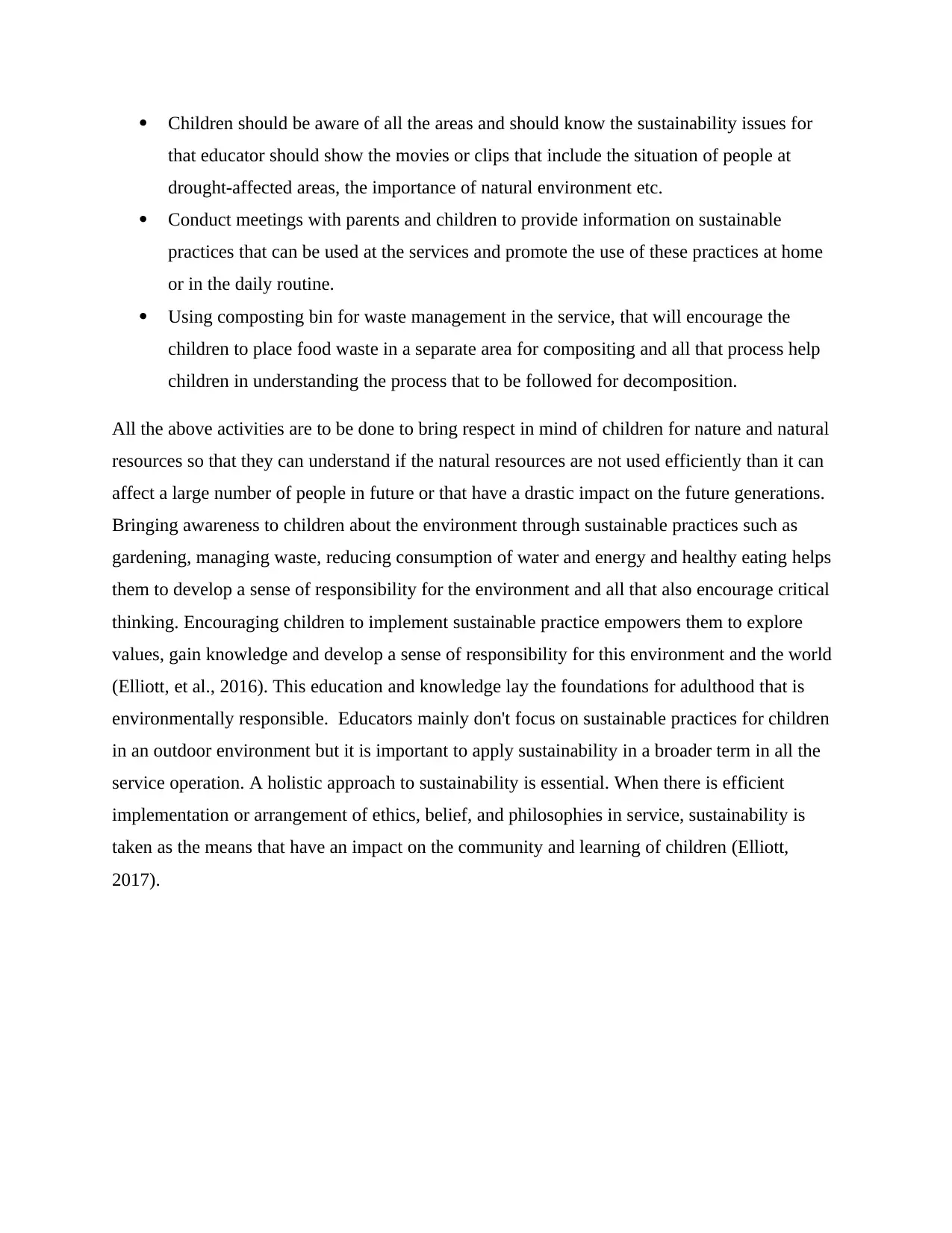
Children should be aware of all the areas and should know the sustainability issues for
that educator should show the movies or clips that include the situation of people at
drought-affected areas, the importance of natural environment etc.
Conduct meetings with parents and children to provide information on sustainable
practices that can be used at the services and promote the use of these practices at home
or in the daily routine.
Using composting bin for waste management in the service, that will encourage the
children to place food waste in a separate area for compositing and all that process help
children in understanding the process that to be followed for decomposition.
All the above activities are to be done to bring respect in mind of children for nature and natural
resources so that they can understand if the natural resources are not used efficiently than it can
affect a large number of people in future or that have a drastic impact on the future generations.
Bringing awareness to children about the environment through sustainable practices such as
gardening, managing waste, reducing consumption of water and energy and healthy eating helps
them to develop a sense of responsibility for the environment and all that also encourage critical
thinking. Encouraging children to implement sustainable practice empowers them to explore
values, gain knowledge and develop a sense of responsibility for this environment and the world
(Elliott, et al., 2016). This education and knowledge lay the foundations for adulthood that is
environmentally responsible. Educators mainly don't focus on sustainable practices for children
in an outdoor environment but it is important to apply sustainability in a broader term in all the
service operation. A holistic approach to sustainability is essential. When there is efficient
implementation or arrangement of ethics, belief, and philosophies in service, sustainability is
taken as the means that have an impact on the community and learning of children (Elliott,
2017).
that educator should show the movies or clips that include the situation of people at
drought-affected areas, the importance of natural environment etc.
Conduct meetings with parents and children to provide information on sustainable
practices that can be used at the services and promote the use of these practices at home
or in the daily routine.
Using composting bin for waste management in the service, that will encourage the
children to place food waste in a separate area for compositing and all that process help
children in understanding the process that to be followed for decomposition.
All the above activities are to be done to bring respect in mind of children for nature and natural
resources so that they can understand if the natural resources are not used efficiently than it can
affect a large number of people in future or that have a drastic impact on the future generations.
Bringing awareness to children about the environment through sustainable practices such as
gardening, managing waste, reducing consumption of water and energy and healthy eating helps
them to develop a sense of responsibility for the environment and all that also encourage critical
thinking. Encouraging children to implement sustainable practice empowers them to explore
values, gain knowledge and develop a sense of responsibility for this environment and the world
(Elliott, et al., 2016). This education and knowledge lay the foundations for adulthood that is
environmentally responsible. Educators mainly don't focus on sustainable practices for children
in an outdoor environment but it is important to apply sustainability in a broader term in all the
service operation. A holistic approach to sustainability is essential. When there is efficient
implementation or arrangement of ethics, belief, and philosophies in service, sustainability is
taken as the means that have an impact on the community and learning of children (Elliott,
2017).
Paraphrase This Document
Need a fresh take? Get an instant paraphrase of this document with our AI Paraphraser
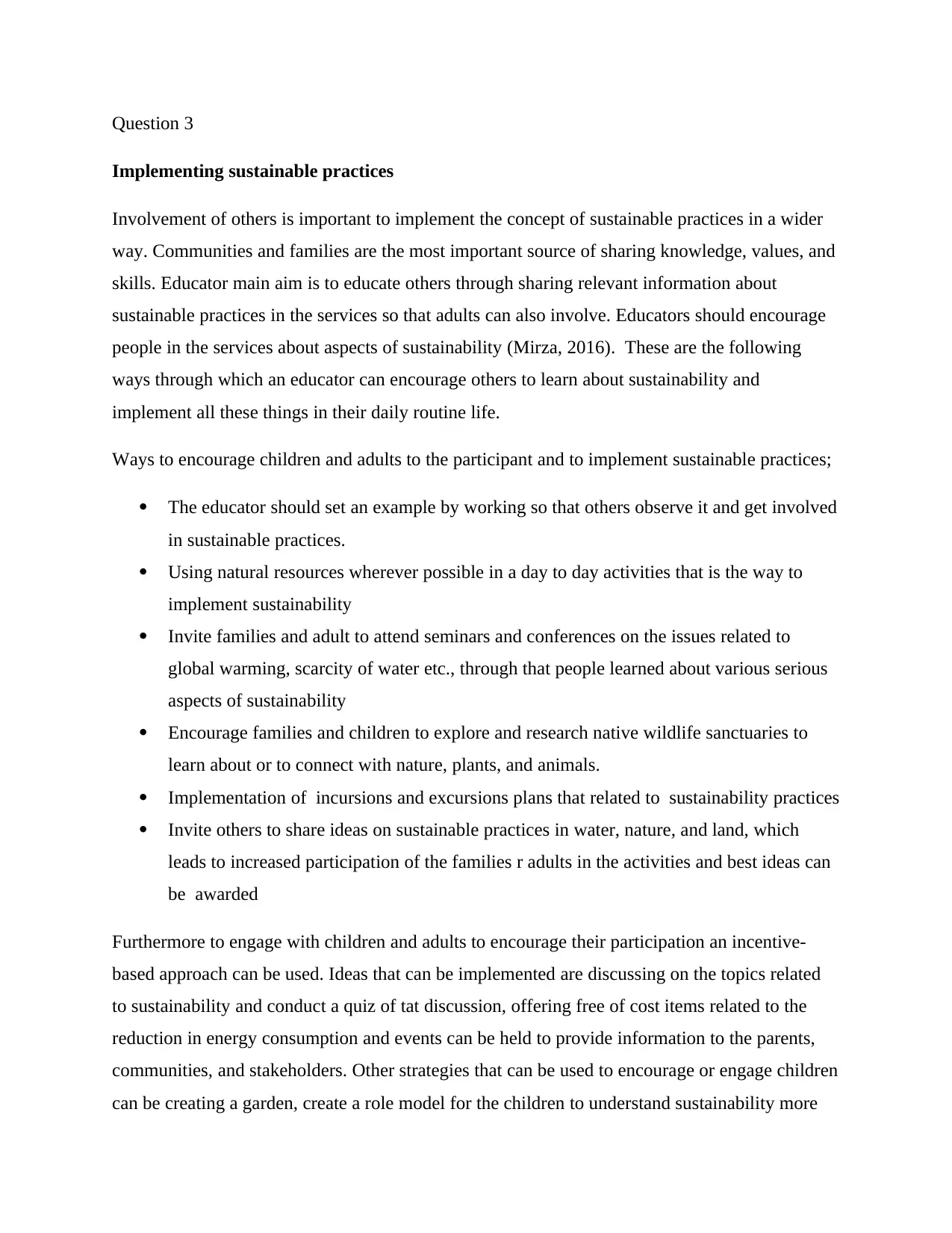
Question 3
Implementing sustainable practices
Involvement of others is important to implement the concept of sustainable practices in a wider
way. Communities and families are the most important source of sharing knowledge, values, and
skills. Educator main aim is to educate others through sharing relevant information about
sustainable practices in the services so that adults can also involve. Educators should encourage
people in the services about aspects of sustainability (Mirza, 2016). These are the following
ways through which an educator can encourage others to learn about sustainability and
implement all these things in their daily routine life.
Ways to encourage children and adults to the participant and to implement sustainable practices;
The educator should set an example by working so that others observe it and get involved
in sustainable practices.
Using natural resources wherever possible in a day to day activities that is the way to
implement sustainability
Invite families and adult to attend seminars and conferences on the issues related to
global warming, scarcity of water etc., through that people learned about various serious
aspects of sustainability
Encourage families and children to explore and research native wildlife sanctuaries to
learn about or to connect with nature, plants, and animals.
Implementation of incursions and excursions plans that related to sustainability practices
Invite others to share ideas on sustainable practices in water, nature, and land, which
leads to increased participation of the families r adults in the activities and best ideas can
be awarded
Furthermore to engage with children and adults to encourage their participation an incentive-
based approach can be used. Ideas that can be implemented are discussing on the topics related
to sustainability and conduct a quiz of tat discussion, offering free of cost items related to the
reduction in energy consumption and events can be held to provide information to the parents,
communities, and stakeholders. Other strategies that can be used to encourage or engage children
can be creating a garden, create a role model for the children to understand sustainability more
Implementing sustainable practices
Involvement of others is important to implement the concept of sustainable practices in a wider
way. Communities and families are the most important source of sharing knowledge, values, and
skills. Educator main aim is to educate others through sharing relevant information about
sustainable practices in the services so that adults can also involve. Educators should encourage
people in the services about aspects of sustainability (Mirza, 2016). These are the following
ways through which an educator can encourage others to learn about sustainability and
implement all these things in their daily routine life.
Ways to encourage children and adults to the participant and to implement sustainable practices;
The educator should set an example by working so that others observe it and get involved
in sustainable practices.
Using natural resources wherever possible in a day to day activities that is the way to
implement sustainability
Invite families and adult to attend seminars and conferences on the issues related to
global warming, scarcity of water etc., through that people learned about various serious
aspects of sustainability
Encourage families and children to explore and research native wildlife sanctuaries to
learn about or to connect with nature, plants, and animals.
Implementation of incursions and excursions plans that related to sustainability practices
Invite others to share ideas on sustainable practices in water, nature, and land, which
leads to increased participation of the families r adults in the activities and best ideas can
be awarded
Furthermore to engage with children and adults to encourage their participation an incentive-
based approach can be used. Ideas that can be implemented are discussing on the topics related
to sustainability and conduct a quiz of tat discussion, offering free of cost items related to the
reduction in energy consumption and events can be held to provide information to the parents,
communities, and stakeholders. Other strategies that can be used to encourage or engage children
can be creating a garden, create a role model for the children to understand sustainability more

deeply, discuss the change with families and force them to implement it at the places they live.
Participation of adults can be increased through these activities and programs. The main focus on
implementing sustainable practices should be on the children as it is very important for the
society to make children aware about the issues of sustainability and to embed the activities of
sustainable practices on their daily routine or life (Emason, 2014). All the above points
described are useful in encouraging and engaging families and children to participate in the
sustainable activities and to learned new ideas and implement that ideas in their daily life that
change in the participant's behavior help in creating a new and friendly environment.
Question 4
Embedding sustainability into service policies and procedures
Sustainability is not limited to implementing some activities related to sustainable practices
rather it needs to be learned and sustained by the people in their life to ignore negative
consequences in the future. This can be attained only through implementing sustainable activities
sin the service policies, procedures, and philosophy. To ensure that this sustainability should be
maintained in all the procedures and policies, reviewing and monitoring should be done regularly
(Barnes & Gindidis, 2018).
Philosophy is considered as the statement of beliefs and norms. To retain theses belief and values
organization practices, policies are procedures are linked with the statement. Procedures and
policies are the tools to transform all the philosophies into practices. For example, the statement
or philosophy of an organization is "nature or protect the natural environment" for that policies
can be formulated like encouraging children to participate in programs that nurture children
learning of natural environment and for that procedure that can be followed is that an
environment can be provided to children that include natural plants, greenery and gardens, and
species of plants so that children can feel and appreciate the natural environment (Armstrong, et
al., 2018). Embedding sustainability in practices can be done through setting daily routine of
children and in that gardening can be included so that they can practice this daily that change
will be embedded in their life.
A good learning experience for children can be possible only by embedding sustainability with
policies and procedures. For example, in-service children wanted to have pets in the premises
Participation of adults can be increased through these activities and programs. The main focus on
implementing sustainable practices should be on the children as it is very important for the
society to make children aware about the issues of sustainability and to embed the activities of
sustainable practices on their daily routine or life (Emason, 2014). All the above points
described are useful in encouraging and engaging families and children to participate in the
sustainable activities and to learned new ideas and implement that ideas in their daily life that
change in the participant's behavior help in creating a new and friendly environment.
Question 4
Embedding sustainability into service policies and procedures
Sustainability is not limited to implementing some activities related to sustainable practices
rather it needs to be learned and sustained by the people in their life to ignore negative
consequences in the future. This can be attained only through implementing sustainable activities
sin the service policies, procedures, and philosophy. To ensure that this sustainability should be
maintained in all the procedures and policies, reviewing and monitoring should be done regularly
(Barnes & Gindidis, 2018).
Philosophy is considered as the statement of beliefs and norms. To retain theses belief and values
organization practices, policies are procedures are linked with the statement. Procedures and
policies are the tools to transform all the philosophies into practices. For example, the statement
or philosophy of an organization is "nature or protect the natural environment" for that policies
can be formulated like encouraging children to participate in programs that nurture children
learning of natural environment and for that procedure that can be followed is that an
environment can be provided to children that include natural plants, greenery and gardens, and
species of plants so that children can feel and appreciate the natural environment (Armstrong, et
al., 2018). Embedding sustainability in practices can be done through setting daily routine of
children and in that gardening can be included so that they can practice this daily that change
will be embedded in their life.
A good learning experience for children can be possible only by embedding sustainability with
policies and procedures. For example, in-service children wanted to have pets in the premises
⊘ This is a preview!⊘
Do you want full access?
Subscribe today to unlock all pages.

Trusted by 1+ million students worldwide
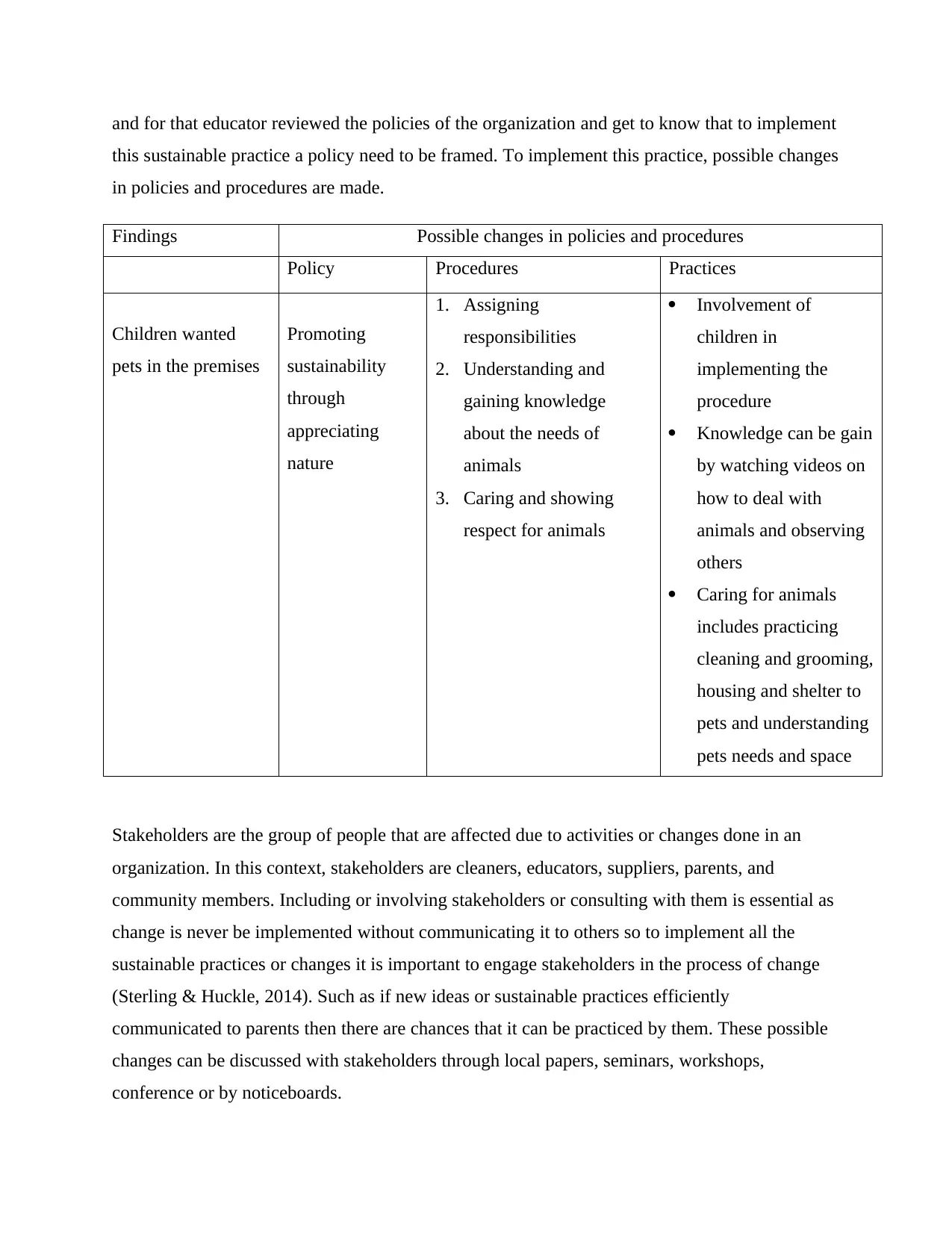
and for that educator reviewed the policies of the organization and get to know that to implement
this sustainable practice a policy need to be framed. To implement this practice, possible changes
in policies and procedures are made.
Findings Possible changes in policies and procedures
Policy Procedures Practices
Children wanted
pets in the premises
Promoting
sustainability
through
appreciating
nature
1. Assigning
responsibilities
2. Understanding and
gaining knowledge
about the needs of
animals
3. Caring and showing
respect for animals
Involvement of
children in
implementing the
procedure
Knowledge can be gain
by watching videos on
how to deal with
animals and observing
others
Caring for animals
includes practicing
cleaning and grooming,
housing and shelter to
pets and understanding
pets needs and space
Stakeholders are the group of people that are affected due to activities or changes done in an
organization. In this context, stakeholders are cleaners, educators, suppliers, parents, and
community members. Including or involving stakeholders or consulting with them is essential as
change is never be implemented without communicating it to others so to implement all the
sustainable practices or changes it is important to engage stakeholders in the process of change
(Sterling & Huckle, 2014). Such as if new ideas or sustainable practices efficiently
communicated to parents then there are chances that it can be practiced by them. These possible
changes can be discussed with stakeholders through local papers, seminars, workshops,
conference or by noticeboards.
this sustainable practice a policy need to be framed. To implement this practice, possible changes
in policies and procedures are made.
Findings Possible changes in policies and procedures
Policy Procedures Practices
Children wanted
pets in the premises
Promoting
sustainability
through
appreciating
nature
1. Assigning
responsibilities
2. Understanding and
gaining knowledge
about the needs of
animals
3. Caring and showing
respect for animals
Involvement of
children in
implementing the
procedure
Knowledge can be gain
by watching videos on
how to deal with
animals and observing
others
Caring for animals
includes practicing
cleaning and grooming,
housing and shelter to
pets and understanding
pets needs and space
Stakeholders are the group of people that are affected due to activities or changes done in an
organization. In this context, stakeholders are cleaners, educators, suppliers, parents, and
community members. Including or involving stakeholders or consulting with them is essential as
change is never be implemented without communicating it to others so to implement all the
sustainable practices or changes it is important to engage stakeholders in the process of change
(Sterling & Huckle, 2014). Such as if new ideas or sustainable practices efficiently
communicated to parents then there are chances that it can be practiced by them. These possible
changes can be discussed with stakeholders through local papers, seminars, workshops,
conference or by noticeboards.
Paraphrase This Document
Need a fresh take? Get an instant paraphrase of this document with our AI Paraphraser
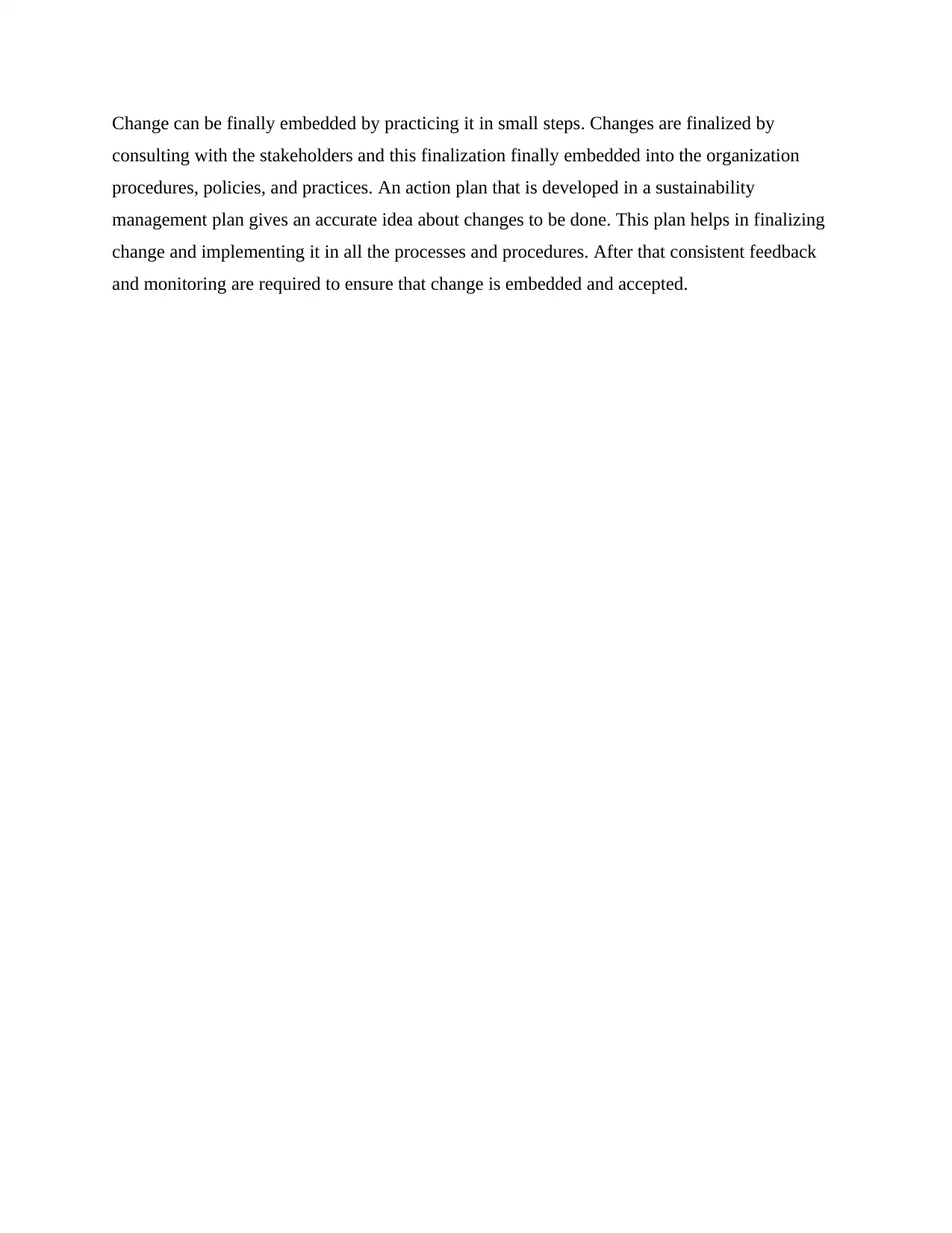
Change can be finally embedded by practicing it in small steps. Changes are finalized by
consulting with the stakeholders and this finalization finally embedded into the organization
procedures, policies, and practices. An action plan that is developed in a sustainability
management plan gives an accurate idea about changes to be done. This plan helps in finalizing
change and implementing it in all the processes and procedures. After that consistent feedback
and monitoring are required to ensure that change is embedded and accepted.
consulting with the stakeholders and this finalization finally embedded into the organization
procedures, policies, and practices. An action plan that is developed in a sustainability
management plan gives an accurate idea about changes to be done. This plan helps in finalizing
change and implementing it in all the processes and procedures. After that consistent feedback
and monitoring are required to ensure that change is embedded and accepted.
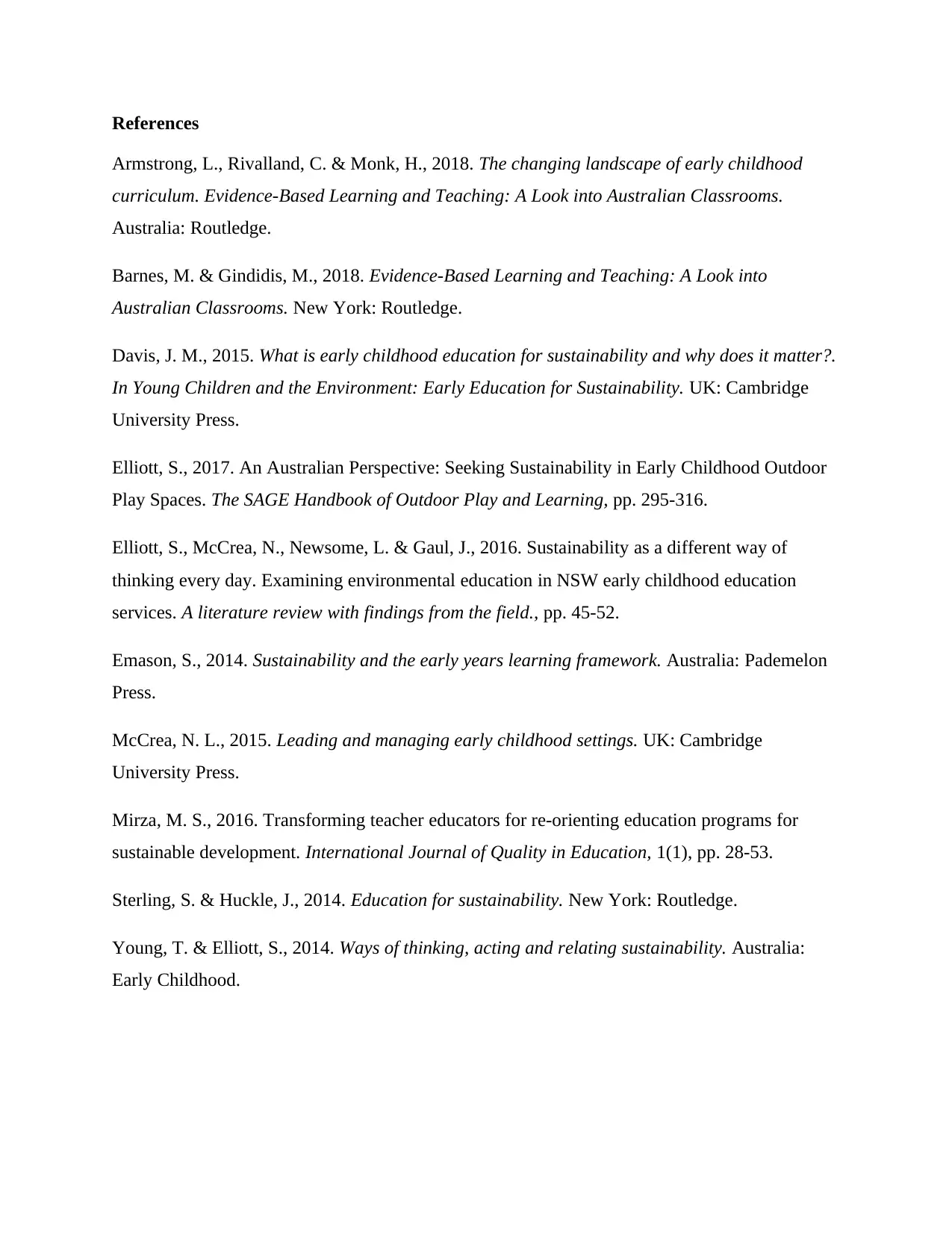
References
Armstrong, L., Rivalland, C. & Monk, H., 2018. The changing landscape of early childhood
curriculum. Evidence-Based Learning and Teaching: A Look into Australian Classrooms.
Australia: Routledge.
Barnes, M. & Gindidis, M., 2018. Evidence-Based Learning and Teaching: A Look into
Australian Classrooms. New York: Routledge.
Davis, J. M., 2015. What is early childhood education for sustainability and why does it matter?.
In Young Children and the Environment: Early Education for Sustainability. UK: Cambridge
University Press.
Elliott, S., 2017. An Australian Perspective: Seeking Sustainability in Early Childhood Outdoor
Play Spaces. The SAGE Handbook of Outdoor Play and Learning, pp. 295-316.
Elliott, S., McCrea, N., Newsome, L. & Gaul, J., 2016. Sustainability as a different way of
thinking every day. Examining environmental education in NSW early childhood education
services. A literature review with findings from the field., pp. 45-52.
Emason, S., 2014. Sustainability and the early years learning framework. Australia: Pademelon
Press.
McCrea, N. L., 2015. Leading and managing early childhood settings. UK: Cambridge
University Press.
Mirza, M. S., 2016. Transforming teacher educators for re-orienting education programs for
sustainable development. International Journal of Quality in Education, 1(1), pp. 28-53.
Sterling, S. & Huckle, J., 2014. Education for sustainability. New York: Routledge.
Young, T. & Elliott, S., 2014. Ways of thinking, acting and relating sustainability. Australia:
Early Childhood.
Armstrong, L., Rivalland, C. & Monk, H., 2018. The changing landscape of early childhood
curriculum. Evidence-Based Learning and Teaching: A Look into Australian Classrooms.
Australia: Routledge.
Barnes, M. & Gindidis, M., 2018. Evidence-Based Learning and Teaching: A Look into
Australian Classrooms. New York: Routledge.
Davis, J. M., 2015. What is early childhood education for sustainability and why does it matter?.
In Young Children and the Environment: Early Education for Sustainability. UK: Cambridge
University Press.
Elliott, S., 2017. An Australian Perspective: Seeking Sustainability in Early Childhood Outdoor
Play Spaces. The SAGE Handbook of Outdoor Play and Learning, pp. 295-316.
Elliott, S., McCrea, N., Newsome, L. & Gaul, J., 2016. Sustainability as a different way of
thinking every day. Examining environmental education in NSW early childhood education
services. A literature review with findings from the field., pp. 45-52.
Emason, S., 2014. Sustainability and the early years learning framework. Australia: Pademelon
Press.
McCrea, N. L., 2015. Leading and managing early childhood settings. UK: Cambridge
University Press.
Mirza, M. S., 2016. Transforming teacher educators for re-orienting education programs for
sustainable development. International Journal of Quality in Education, 1(1), pp. 28-53.
Sterling, S. & Huckle, J., 2014. Education for sustainability. New York: Routledge.
Young, T. & Elliott, S., 2014. Ways of thinking, acting and relating sustainability. Australia:
Early Childhood.
⊘ This is a preview!⊘
Do you want full access?
Subscribe today to unlock all pages.

Trusted by 1+ million students worldwide
1 out of 9
Related Documents
Your All-in-One AI-Powered Toolkit for Academic Success.
+13062052269
info@desklib.com
Available 24*7 on WhatsApp / Email
![[object Object]](/_next/static/media/star-bottom.7253800d.svg)
Unlock your academic potential
Copyright © 2020–2025 A2Z Services. All Rights Reserved. Developed and managed by ZUCOL.





